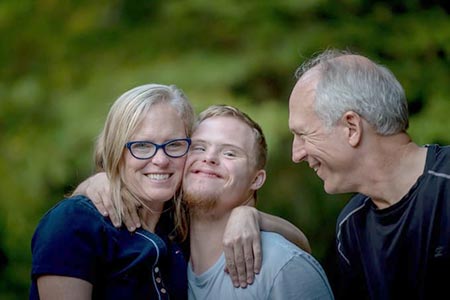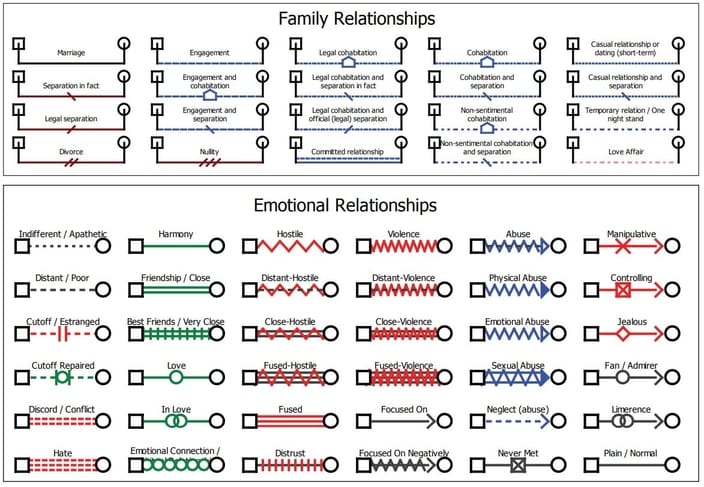What is the Importance of a Genogram?
 A family tree exhibits the connection of
A family tree exhibits the connection of
one member of the family to another, whether it’s by blood,
by marriage, by kinship, or by adoption
What is a Genogram?
A genogram is an expanded version of the family tree which includes behavioral patterns, descriptions on the quality of relationships, individual traits, historical facts, and other family dynamics. It can span from two to three generations or more, depending on how much information you can gather about your whole family.
Genograms were developed by Randy Gerson and Monica McGoldrick for their studies in family therapy and clinical psychology. It was explained in detail in the book they released in 1985. Using this system, individuals can be described in the context of their whole family including parents, siblings, parents, grandparents, and spouses.
Each individual in the genogram is represented by a symbol. They’re connected using lines which help describe the kind of relationship they have with the other entities.
 Standard genogram symbols
Standard genogram symbols
Genograms don’t usually look the same for prolonged periods. As they’re designed to describe the current relationship of a member with the rest of the family, they really tend to change after a year or two.
Genograms of families on the brink of breaking off are usually made of squiggly lines as if a child got hold of a pen for the first time. But after mending the relationship, fewer curvy lines and color appear on their genogram.
People in the field of family therapy, medicine, genetic research, social work, and education use genograms to better understand the family dynamics that affect the actions and behaviors of each entity in the multi-generational diagram.
The Importance of a Genogram
Genograms help depict the key people in an individual’s life and their relationship with them. This tool makes it easier for professionals to identify where issues and concerns come from within the family.
A genogram is also a very helpful tool in the realm of social work. For one, it can invite people to share their perception of their identity in terms of gender, culture, race, and ethnicity, helping social workers understand more about their subject.
Genograms are often used by professionals for the following purposes:
Risk assessment
Professionals in the medical field can look at your genogram to identify possible medical risk factors. Those with an extensive history of diabetes, heart disease, anemia, or any other illness that has a high probability of being passed down to those next in line will have a better survivability rate because doctors can promptly assist individuals in making appropriate lifestyle choices.
Similarly, insurance policy providers may also use this as a reference to determine your medical history and assess what kind of plan they can give you.
Research
Researchers in behavioral studies can use genograms to spot recurring patterns and correlated elements on how individuals from different generations behave. Genograms can also help understand how socio-economic, environmental, and political factors influence family functions and development.
 The Skywalker family genogram
The Skywalker family genogram
Having someone in the family serve in the military often introduces stressors, priorities, perspectives, and culture unique to them. The occupational hazard involved in this line of work can affect relationships and the values each member upholds.
Genograms of individuals who belong to families in the minority groups may also show differences in aspects like tradition, belief, bonding strength, and values when compared to the genogram of someone who’s born in a more dominant group.
By comparing the genograms of people coming from different backgrounds, social workers are able to understand better the essentials and nonessentials of every group in the community. This helps them create holistic reports and recommendations they can feed to the government to ensure that the needs and opportunities are fairly provided to everyone in the region.
Counselling
Genograms help mental health professionals like psychiatrists understand the relationships of an individual with the people around them. They reveal the influences, the support system, and the extent of the social network of an individual. Using genograms, professionals can identify which of these areas are doing well and which of them need improvement. From here, treatment plans can be tweaked into targeting unhealthy and unhelpful relationships.
Couples can also benefit from genograms by getting insight into the influences of the individual families in their relationship. It will be easier to spot any developmental issues arising from family history and identify possible conflicts which may come into the picture as the couple’s relationship grows. Understanding their differences and compatibility will help strengthen their relationship in the long run.
Guidance counselors are meant to assist students in personal development and career selection. Using genograms, counselors can discern which behavior and relationships support the goals and aspirations of the student. Pieces of advice can then be given on how to use these positive factors to ensure growth and development.
Substance abuse
Genograms can be used to understand the current relationships of the patient and identify which ones trigger, support, or inhibit further substance usage. New relationships that will help the patient completely abstain and recover from abusive usage can also be identified through genograms.
Therapy
Youngsters who undergo an abusive relationship tend to keep tight-lipped about their everyday struggles. Their parents and friends usually have a hard time convincing these young people to open up, much less professionals who are stranger to them. But magically, the illustrated nature of a genogram can break open the clammed up kids, letting them express their feelings through drawings.
People who construct the genograms themselves find the activity therapeutic possibly because they’re able to let out the feelings welling up inside them. Many people may feel uncomfortable talking about their issues in person, so having another medium where they can pour outtheir thoughts and feelings can be a great relief.
Genograms can also help people overcome barriers brought about by family issues. As they draw their own chart, they start to see the connections and patterns related to their problem. This broadens their perspective and frees them from the limiting belief that everything is to be blamed on a single person in the family.
 Genogram relationship connectors
Genogram relationship connectors
Aside from depicting family relationships and generational trends, genograms can be designed to obtain other types of information. Spiritual genograms, for example, can be used to capture the effect of spiritual affiliations, religions, and practices on family ties and individual character.
The genogram is a very versatile tool in determining family relationships, pinpointing areas of improvement in the social network of a person and spotting the likelihood of disease from getting passed down the generation. It makes summarizing information about an individual without missing out on the important details possible for professionals coming from different fields of study.
Creating a Genogram
You can create a genogram with just paper and pencil or with a software like GenoPro. However, if you just use paper and a pencil, this can become messy and, at times, hardly comprehensible, especially when the different kinds of lines and color-coding come into the picture.
Creating a genogram shouldn’t be difficult and flavorless. With the GenoPro software, you can draw the most comprehensive genogram of your family in minutes. Its intuitive UI makes it easy to use even for beginners. And the best part is you can try it for free!